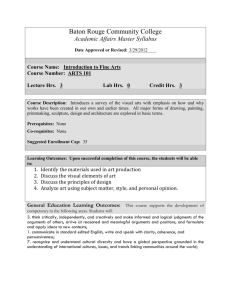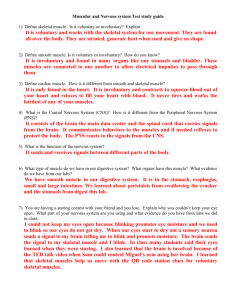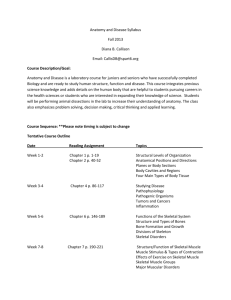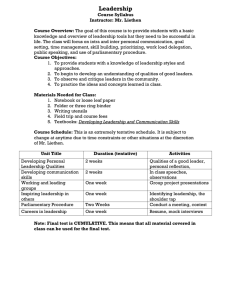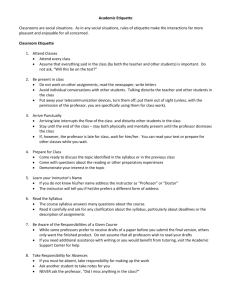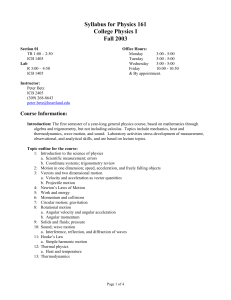Syllabus - Victoria College
advertisement
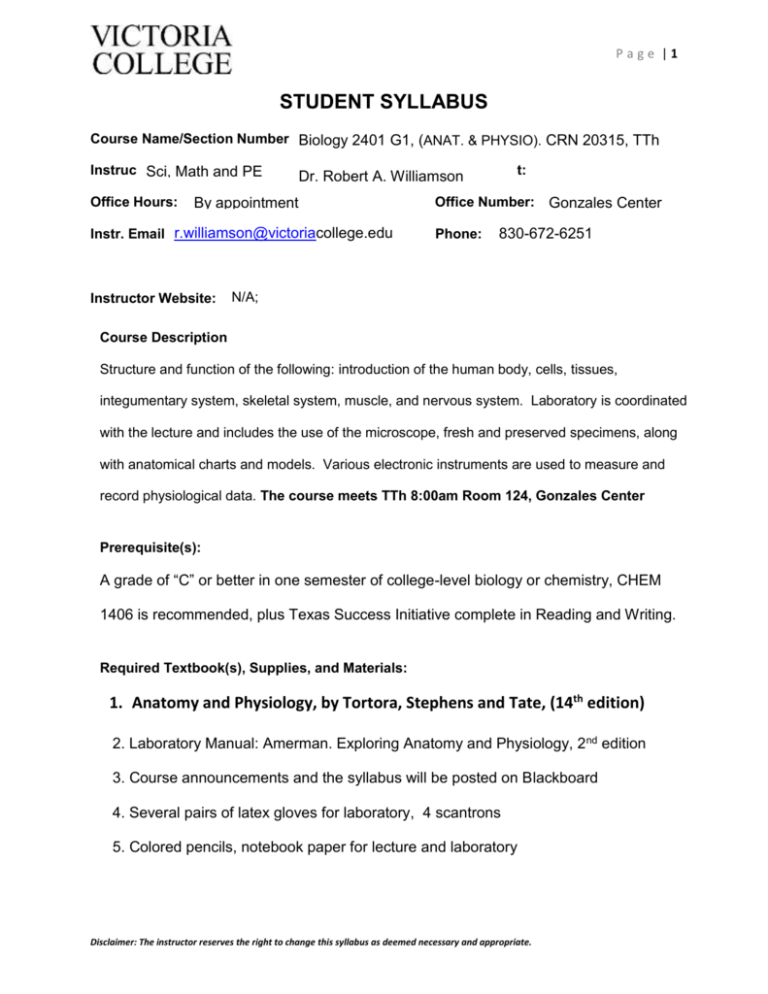
Page |1 STUDENT SYLLABUS Course Name/Section Number: Biology 2401 G1, (ANAT. & PHYSIO). CRN 20315, TTh Instructor Name: Sci, Math and PE Office Hours: Division/Dept: Dr. Robert A. Williamson By appointment Office Number: Instr. Email: r.williamson@victoriacollege.eduOffice Phone: Instructor Website: Gonzales Center 124 830-672-6251 N/A; Course Description Structure and function of the following: introduction of the human body, cells, tissues, integumentary system, skeletal system, muscle, and nervous system. Laboratory is coordinated with the lecture and includes the use of the microscope, fresh and preserved specimens, along with anatomical charts and models. Various electronic instruments are used to measure and record physiological data. The course meets TTh 8:00am Room 124, Gonzales Center Prerequisite(s): A grade of “C” or better in one semester of college-level biology or chemistry, CHEM 1406 is recommended, plus Texas Success Initiative complete in Reading and Writing. Required Textbook(s), Supplies, and Materials: 1. Anatomy and Physiology, by Tortora, Stephens and Tate, (14th edition) 2. Laboratory Manual: Amerman. Exploring Anatomy and Physiology, 2 nd edition 3. Course announcements and the syllabus will be posted on Blackboard 4. Several pairs of latex gloves for laboratory, 4 scantrons 5. Colored pencils, notebook paper for lecture and laboratory Disclaimer: The instructor reserves the right to change this syllabus as deemed necessary and appropriate. Page |2 Learning Outcomes: 1. Demonstrate the use of logical reasoning and knowledge of levels of organization, cell structure & function, tissues, integumentary system, skeletal system, muscle, and nervous system. 2. Demonstrate knowledge of levels of organization, cell structure & function, tissues, integumentary system, skeletal system, muscle, and nervous system. The student will demonstrate the use of appropriate technology in the laboratory to study these systems. 3. Demonstrate the use of logical reasoning and knowledge of levels of organization, cell structure & function, tissues, integumentary system, skeletal system, muscle, and nervous system. Assessments: Course material will be assessed through the use of laboratory and classroom exams. 1. Given a series of online web pages illustrated with graphics &/or traditional lectures, as well as associated text readings, you will need to demonstrate knowledge of levels of organization, cell structure & function, tissues, integumentary system, skeletal system, muscle, and nervous system on major examinations. 2. Given charts, models, microscopes with microscopic slides, live & preserved specimens, electrophysiological equipment, spirometers, and a lab manual, you will need to demonstrate knowledge of levels of organization, cell structure & function, tissues, integumentary system, skeletal system, muscle, and nervous system on 4 lab practical examinations. 3. Comprehensive final examination. Disclaimer: The instructor reserves the right to change this syllabus as deemed necessary and appropriate. Page |3 SCANS: Students should be able to use and develop the following competencies and skills: Reading: Locate, understand, and interpret written information in prose and in documents such as manuals, graphs, and schedules. Writing: Communicate thoughts, ideas, information, and messages in writing, and create documents such as letters, directions, manuals, reports, graphs, and flow charts. Speaking and Listening: Organize ideas and communicate orally; receive, attend to, interpret, and respond to verbal messages and other cues. Thinking Skills: A worker must think creatively, make decisions, solve problems, visualize, know how to learn, and reason effectively. Personal Qualities: A worker must display responsibility, self-esteem, sociability, selfmanagement, integrity, and honesty. Workplace Competencies: resources; interpersonal skills; information; systems; and technology. Basic use of computers Course Requirements: Emphasis will be placed on time management and in the improving of study skills. Be respectful to your instructor and classmates. While it is the final responsibility of the student to drop a class that she/he is no longer attending, instructors MUST drop a student who has not physically attended a face-toface or hybrid class prior to the ORD. Instructors, MAY at their discretion drop a student who is not passing without consultation with the student when absences exceed 20% of the scheduled class meetings. For classes that include a separate laboratory, a student may be dropped when absences exceed 20% of the laboratory meetings or 20% of the lecture meetings. Instructors MUST drop a student who is not passing when absences exceed 40% of the scheduled class meetings unless said excessive absences accrue after the 65% drop date. Instructors CANNOT drop a student after 65% of class instruction has been completed. The ORD for this class is February 3. The last day to drop is April 6, 2016. Disclaimer: The instructor reserves the right to change this syllabus as deemed necessary and appropriate. Page |4 Criteria for Grading: All instructors of this course will use the same textbook and lab manual. Your exams and final will be multiple choice. You may make up an exam ONLY under the most extreme circumstances and with proper documentation. You must notify me prior to the absence. Failure to do so will result in a zero for the missed exam. A comprehensive, all essay make-up exam covering the entire semester will be given the last week of classes. You do not want to take the make-up for the final! Lab exams are practicals involving anything from whole specimens to microscopic slide sections – be prepared. You will receive only one final lecture grade and you must pass both the lab 60% and lecture in order to pass this course. If you receive a grade less than 70% on an exam, please come by and meet with me within one week of receiving the grade in order to discuss ways for improvement. You are responsible for all marks placed on your scantrons. Points will not be awarded for stray or incorrect ticks picked up by the machine. Lecture Exams: # 1, 2, 3 15% each 45% Final Lecture Exam 30% Lab Final Average Final Course Grade 25% _______ 100% Final Course Grade Standards: 90-100% 80-89.9% 70-79.9% 60-69.9% 0-59.9% =A =B =C =D =F Disclaimer: The instructor reserves the right to change this syllabus as deemed necessary and appropriate. Page |5 Attendance: Attendance will be taken for every class meeting. Regular and prompt class attendance is expected of every student. A student’s absence means that the student is not able to participate in the class. Lecture and Lab are mandatory. Roll will be taken each lecture and lab period throughout the semester. Consider this statement, “If you are on time… you are already late”. Attendance means being in class, arriving before the designated start time and remaining until the class is finished. Cellular phones, ipods, beepers etc. must be turned off during class and all testing. Academic Misconduct: -- We will use the VC Student Code of Conduct Special Needs: -- Students must contact the VC Counseling and Career Center (361)-572-6414 located in the Admin. II bld. before visiting with me for academic accommodations. Please Remember: Biology 2401 introduces students to the conceptual and laboratory foundations of anatomy and physiology. Students will study the structure and function of the human body beginning from the molecular level of organization. A greater appreciation for the basic characteristics of life including development and disease is expected. The student should be able to answer and/or identify questions pertaining to the lecture notes, text readings and laboratory exercises assigned. Disclaimer: The instructor reserves the right to change this syllabus as deemed necessary and appropriate. Page |6 Biology 2401 Schedule for Spring 2016 Class Schedule Day Date Tuedays and Thursdays Week Class# Chapter T Jan 19 TH 21 T 26 TH 28 T Feb 2 TH 4 T 9 1 “ 2 “ 3 “ 4 1 2 3 4 5 6 7 1 “ 2 “ “ 3 “ TH “ 8 EXAM I 5 “ 76 “ 7 “ 8 9 10 11 12 13 14 15 4 4,5 5,6 “ 7 8 10 16 MID TERM EXAM 14-18 OFF SPRING BREAK 11 T 16 TH 18 T 23 TH 25 T MAR 1 TH 3 T 8 TH 8:00AM (promptly) to 9:15AM Topic Pages Orientation, Introduction to the Human Body 1-28 The Chemical Level of Organization 29-62 The Cellular Level of Organization 63-112 (Covers chapts. 1,2,3) The Tissue Level of Organization The Integumentary System The Skeletal System: Bone Tissue “ The Skeletal System: The Axial Skeleton The Skeletal System: Appendicular Skeleton “ 113-152 153-181 182-207 208-254 255-288 (Covers chapts. 4,5,6,7,8) T 22 TH 24 T 29 TH 31 T April 5 TH 7 9 “ 10 ” 11 “ 17 18 19 20 21 22 9 “ 10 11 12 12 T 12 12 23 EXAM 3 TH T TH T TH T May TH 14 19 21 26 28 3 5 “ 13 “ 14 “ 15 “ 24 25 26 27 28 29 30 13 “ 14 “ 15 16 “ Spinal Cord and Spinal Nerves 492-526 The Brain and Cranial Nerves 527-580 The Autonomic Nervous System Sensory, Motor & Integrative Systems “ 581-605 606-634 16 31 FINAL EXAM (comprehensive, with emphasis on Chapts 13,14,15,16) T May 10 or 12 Joints “ Muscle Tissue The Muscular System Nervous Tissue “ 289-326 327-365 366-446 447-491 (Covers chapts. 9,10,11,12) Instructor reserves the right to alter this tentative schedule with appropriate notice to class. Disclaimer: The instructor reserves the right to change this syllabus as deemed necessary and appropriate.

